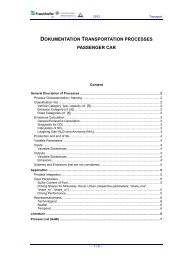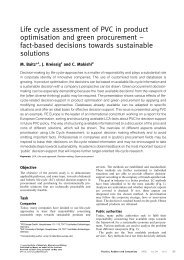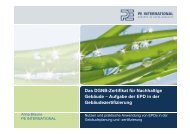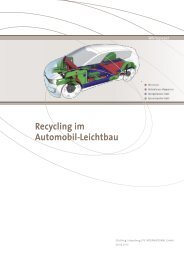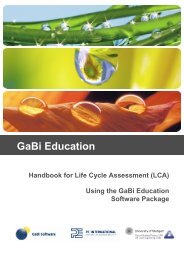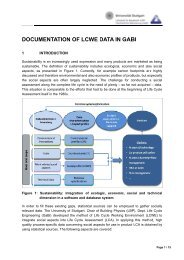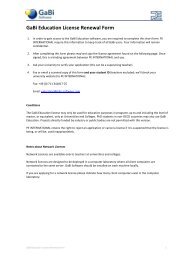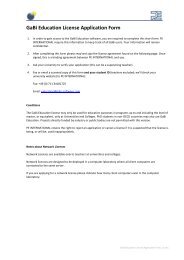GaBi Education - GaBi Software
GaBi Education - GaBi Software
GaBi Education - GaBi Software
You also want an ePaper? Increase the reach of your titles
YUMPU automatically turns print PDFs into web optimized ePapers that Google loves.
Conducting Life Cycle Assessments<br />
procedures, etc. This element is especially important when different alternatives<br />
are compared so that significant differences or the lack of them can be understood<br />
and reliable.<br />
Consistency check: The consistency of the used methods and the goal and<br />
scope of the study is checked. Some relevant issues to check could be: data<br />
quality, system boundaries, data symmetry of time period and region, allocation<br />
rules and impact assessment.<br />
2.4.3 Conclusions, recommendations and reporting<br />
The goal of the life cycle interpretation phase is to draw conclusions, identify limitations<br />
and make recommendations for the intended audience of the LCA. The conclusions are<br />
drawn from an iterative loop with the other elements of the interpretation phase in the<br />
sequence that follows:<br />
Identify the significant issues;<br />
Evaluate the methodology and results for completeness, sensitivity and<br />
consistency; and<br />
Draw preliminary conclusions and check that these are consistent with the<br />
requirements of the goal and scope of the study.<br />
If the conclusions are consistent, they are reported as final conclusions. Otherwise one<br />
might return to the previous steps until consistent conclusions are obtained.<br />
A thorough analysis of the data quality requirements, the assumptions, and the predefined<br />
values needs to be done. When the final conclusions of the study are drawn,<br />
recommendations to decision-makers are made to reflect a logical and reasonable<br />
consequence of the conclusions.<br />
2.4.4 Report<br />
The results of the Life Cycle Assessment should be assembled in a comprehensive report<br />
to present the results in a clear, transparent and structured manner. The report should<br />
present the results of the LCI and LCIA and also all data, methods, assumptions and<br />
limitations in sufficient detail.<br />
The reporting of the results should be consistent with the goal and scope definition. The<br />
type and format of the report is defined in the scope definition and will vary depending on<br />
the intended audience.<br />
The ISO 14044 requires full transparency in terms of value choices, rationales, and expert<br />
judgments. If the results will be reported to someone who is not involved in the LCA study,<br />
i.e. third-party or stakeholders, any misrepresentation of the results should be prevented.<br />
The reference document should consist of the following elements (ISO 14044):<br />
1. Administrative Information<br />
a. Name and Address of LCA Practitioner (who conducted the LCA study)<br />
b. Date of Report<br />
c. Other Contact Information or Release Information<br />
2. Definition of Goal and Scope<br />
25



